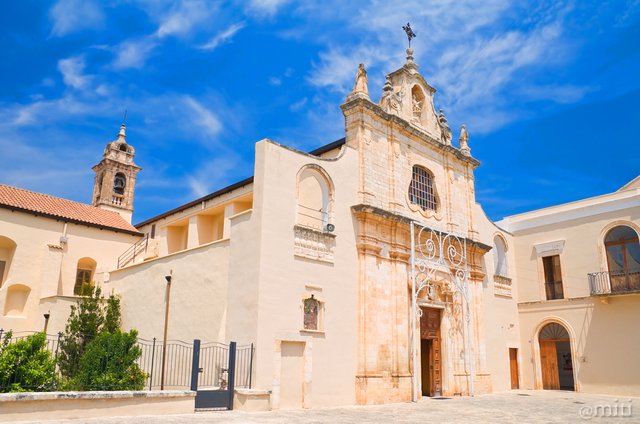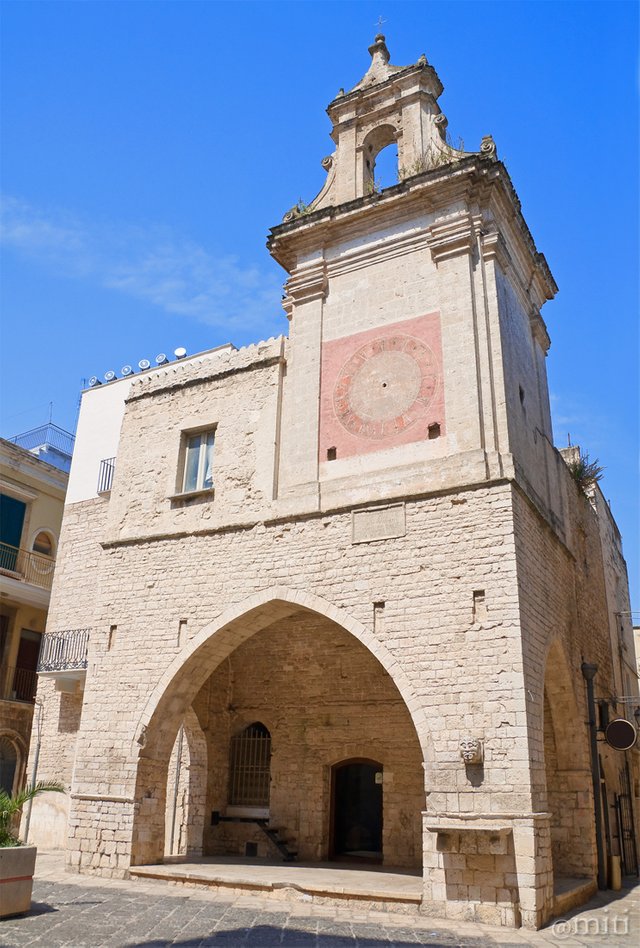A Journey through Italy: one photo every day #109 - BITETTO [ENG/ITA]

The Shrine of Blessed James (Author's photo - All rights reserved)
Il Santuario del Beato Giacomo (Immagine dell'autore - tutti i diritti sono riservati)



Ciao a tutti,
questo è un viaggio attraverso l'Italia. Posterò una foto al giorno con una brevissima descrizione. Spero vi piaccia!

Bitetto è un borgo medievale in provincia di Bari, nella regione meridionale italiana della Puglia. Si trova a 139 metri sul livello del mare, tra l'altopiano carsico delle Murge e il mare Adriatico.
Alcuni storici ritengono che fosse in origine una colonia greca di nome Hetium, una città di cui parlava Plinio, situata vicino a Bitonto, Palo e Grumo. Fu distrutta due volte dai Saraceni, da Guglielmo il Malo nel 1164 e da Corrado IV nel 1251, per aver parteggiato per papa Innocenzo IV. Quando fu ricostruita, gli abitanti anteposero al nome Hetium il prefisso Beth, ottenendo il termine Bethethium, volgarizzato nel 1300 in Beteto.
Bitetto si trova in una zona abitata dal IV secolo. b.C., come testimoniato dalla scoperta di alcuni reperti sepolcrali nella zona, anche se la prima testimonianza storica scritta risale al 959, che mostra l'impegno dei residenti ad onorare una tassa annuale per l'arcivescovo di Bari.
In epoca normanna, l'imperatore Federico II espropriò parte del territorio della città e la vendette all'emergente Altamura, dove si insediarono gli abitanti di Bitetto. Sotto gli Angioini l'insediamento divenne uno dei centri più ricchi e floridi della città la zona.
La città decadde definitivamente intorno alla metà del sec. XVI, a causa di una grave epidemia di peste. Fu sede vescovile dal IX secolo al 1818.
Oltre al centro storico medievale con le torri e le mura ben tenute, di sicuro interesse è la Cattedrale di San Michele Arcangelo del XIV secolo, uno dei principali esempi di architettura romanica pugliese. Fu costruita tra la fine dell'XI e l'inizio del XII secolo. Il corpo centrale è a croce latina mentre le cappelle e la torre campanaria sono del Settecento. Notevoli la statua in argento raffigurante l'Arcangelo Michele in trionfo, di scuola napoletana, ed il settecentesco altare maggiore in marmo policromo.
Il Santuario di Beato Giacomo (Beato Giacomo) risale al 1432 quando Papa Eugenio IV autorizzò la costruzione di una chiesa e di un convento per ospitare una comunità di Frati Minori Osservanti. Il monastero, anch'esso costruito nel 1432, conserva le spoglie del Beato Giacomo Illyria, morto nel 1580. All'interno del Convento, Negli spazi del Convento, precisamente in quelle che erano le cucine e le celle dei Frati, si trova oggi il Museo della Devozione e del Lavoro. La chiesa è a tre navate con volta a botte e finestre barocche.
Meritano una visita il Palazzo Baronale, il Palazzo del Sedile, il Convento di Santa Chiara (1616), la Chiesa di San Domenico (1598), la Chiesa di San Rocco (1760), la Chiesa di San Giuseppe, la Chiesa di Santa Maria Maddalena (XIII secolo), la Chiesa di Santa Maria La Veteran (costruita prima dell'anno 1000) e la Cappella del Beato, dove in vita, il Beato Giacomo Illyria era solito pregare.
Cose da vedere: Il Centro Storico, la Cattedrale di San Michele Arcangelo, il Santuario di Beato Giacomo, il Palazzo Baronale, il Palazzo del Sedile, il Convento di Santa Chiara, la Chiesa di San Domenico, la Chiesa di San Rocco, la Chiesa di San Giuseppe, la Chiesa di Santa Maria Maddalena, la Chiesa di Santa Maria La Veterana, la Cappella del Beato, il Museo della Devozione e del Lavoro.

Hello everyone,
I began a Photo Journey through Italy. I will post one photo every day with a little note of explanation. I hope you like it!

Bitetto is a medieval town in the province of Bari, in the southern Italian region of Puglia. It is located 139 metres above sea level, between the karst plateau of the Murge and the Adriatic Sea.
Some historians believe that this was originally a Greek colony named Hetium, a town that Pliny spoke of, as located near Bitonto, Palo and Grumo. It was twice destroyed by the Saracens, then by William the Bad in 1164 and Conrad IV in 1251, for having supported Pope Innocent IV. When it was rebuilt, its inhabitants added the prefix Beth to the name Hetium, resulting in the word Bethethium, which became Beteto in the local language by 1300.
Bitetto sits in an area inhabited since the IV century. b.C., as witnessed by the discovery of some burial finds in the area, although the first written historical record dates back to 959, showing the commitment of the residents to honour an annual fee to the archbishop of Bari.
In the Norman Ages, the emperor Frederico II expropriated part of the territory of the city and sold it to the emerging Altamura, where the inhabitants of Bitetto settled in. Under the Angevin the settlement became one of the most wealthy and flourishing centres of the Bari area.
The town finally submitted a period of abandon around mid XVI century, due to a serious outbreak of plague. It was a Bishop seat from the IX century to 1818.
Besides the medieval old town with the well-kept towers and walls, other remarkable sights is the 14th century Cathedral of San Michele Arcangelo, one of the main examples of Apulian Romanesque architecture. It was built between the late XI and early XII century. The main building is a Latin cross and the chapels and bell tower of the XVIII century. Inside it preserves the silver statue of the Archangel Michael in triumph, of the Neapolitan school, and the XVIII century altar in polychrome marble.
The Shrine of Beato Giacomo (Blessed James) goes back to 1432 when Pope Eugenius IV authorized the construction of a church and a convent to house a community of Friars Minor Observant. The monastery, which was also built in 1432, preserves the remains of Blessed James Illyria, who died in 1580. Inside the Convent, specifically the kitchens and the cells of the friars, are now the showrooms of the Museum of Work and Worship. The church has one major nave and two large aisles, covered with a barrel vault and proposes superb Baroque windows.
Worth a visit the Baron's Palace, the Sedile Palace, the Convent of Santa Chiara (1616), the Church of San Domenico (1598), the Church of San Rocco (1760), the Church of St. Joseph, the Church of Santa Maria Maddalena (XIII century), the Church Santa Maria La Veteran (built before year 1000) and the Chapel of the Blessed, where, in life, the Blessed James Illyria used to pray.
Thing to see: The Historic Centre, the Cathedral of San Michele Arcangelo, the Shrine of Beato Giacomo, the Baron's Palace, the Sedile Palace, the Convent of Santa Chiara, the Church of San Domenico, the Church of San Rocco, the Church of St. Joseph, the Church of Santa Maria Maddalena, the Church Santa Maria La Veteran, the Chapel of the Blessed, the Museum of Work and Worship.

| Tipo di foto / Category | Paesaggio / Landscape view |
| Esposizione / Settings | 1/250 sec, ISO 200, f/10 |
| Camera | Nikon D5000 |
| Lente / Lens | Tamron SP 17-50mm f/2.8 XR Di II LD |
| Filtro / Filter | Polarizzatore Hoya / Hoya Polarizing filter |
| Cavalletto / Tripod | Manfrotto MKC3-P01 |
| Località / Location | Bitetto (Bari), Italia |
| Software | Photoshop |


The Sedile Palace (Author's photo - All rights reserved)
Il palazzo del Sedile (Immagine dell'autore - tutti i diritti sono riservati)
lovely sunshine..
Congratulations, Your Post Has Been Added To The Steemit Worldmap!
Author link: http://steemitworldmap.com?author=miti
Post link: http://steemitworldmap.com?post=a-journey-through-italy-one-photo-every-day-109-bitetto-eng-ita
Want to have your post on the map too?
Un giorno dovresti postare una specie di raccolta di tutti questi posti che descrivi sia con foto che a parole, magari suddiviso per regione....non sarebbe una cattiva idea! Così quando capito da qualche parte già so cosa andare a vedere 😬😬
Ma lo sai che ci stavo pensando? Diciamo che ho già qualche idea in merito.. ;-)
La tua prima immagine mi ha ricordato molto l'ambientazione di uno dei miei film che ho avuto modo di ricordare in un post di alcuni giorni fa: Lo chiamavano Trinità.
In particolar modo la chiesa di un colore particolarmente chiare e che sembra quasi essere stata stinta o bruciata dal sole.
Non a caso il film è stato girato in Italia (appennino abruzzese) anche se Bitetto è in Puglia, le affinità sono molte.
Si, conosco bene quel film essendo un fan del Film e degli attori che lo interpretavano. In effetti con un uno sterrato davanti al posto del piazzale piastrellato, poteva sembrare quello che hai detto tu..
I remember that you have made posts of beautiful places from Puglia region before and the whole region seems to be filled with an unbelievable amount of history.
As I read about Bitetto and it historic heritage and possible connection with the Greeks I could only imagine the amount of historic knowledge. that must be stored int this place
Yes, there's a lot of history in this town.
@miti 2nd picture is also church or house ???
It's an historical palace seat of the City Government.
Wow really nice place.
Do you keep uploading such beautiful pics??
Because I just loved them.
I will certainly be doing so.
This post is supported by @tipU upvote :)
@tipU voting service guide | For investors.
Good sharing,sir. I love to read your blog
Nice picture.. it's getting hot in italy nowadays..